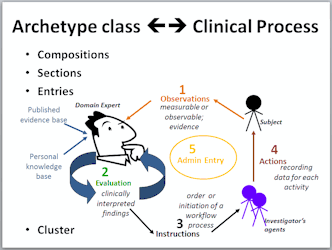Pregnancy Care Record approachPregnancy Care Record approachPregnancy Care Record approachApproach
The Northern Territory approach to the creation of an electronic Pregnancy Health Record is to use clinically-agreed archetypes as the basis for an Antenatal software development.
An archetype is a structured, computable specification for one single, discrete clinical concept. Examples include Blood Pressure; Clinical Synopsis; Medication order; or Adverse Reaction.
In fact, each archetype is a rich pattern for health data, defined and agreed by the clinicians and other stakeholders. Clinician leadership and involvement is critical to ensure the quality of clinical data in our EHRs and to warrant that it is safe and 'fit for purpose'.
The agreed archetype is the basis for a coherent and consistent approach for the whole continuum of electronic clinical care and related activities:
- Recording, storing and querying health information in electronic health information;
- Exchanging health information - the broader the agreement & governance, the greater the potential for interoperability;
- Data aggregation;
- Knowledge-based activities, such as clinical decision support; and
- Comparative data analysis.
Each archetype is designed:
- As a maximal data set effectively everything one can think of about a clinical concept for any user or stakeholder.
- For the 'universal use-case' – for re-use in any and all scenarios, from use at home, to primary care, community care, hospital care, secondary use, health planning and for research.
Archetype types
There are four main types (or classes) of archetypes that are useful to understand – each corresponding to classes in the openEHR Reference Model and each has particular attributes that correspond to clinical processes.
1. Compositions – which correspond to commonly used clinical documents, such as 'antenatal visit' or 'care plan'. (Think of these as the equivalent to the blank piece of paper in a current paper record, before you start to write.)
2. Sections – these are effectively used to assist with human navigation within EHRs and correspond to document headings, for example 'antenatal examination' or 'summary'. (Think of these as the headings that provide a framework for writing on a blank piece of paper.)
3. Entries – these are the most common and are fundamental building blocks of EHRs and will contain most of the 'stand-alone' structured clinical information. There are four main types of Entry archetypes:
- Observations – think of these as the evidence and usually includes the patient history, examination findings, test results, measurements and other observable data. Examples include e.g. blood pressure, Apgar Score, pathology test or weight;
- Evaluations – think of these as the clinically interpreted findings, where the clinician looks at the evidence provided by the Observations and makes a clinical judgement or assessment e.g. adverse event, diagnosis or assessment of risk;
- Instructions – think of these as the orders or requests for care – used to record the initiation of a workflow process, such as a medication order or referral;
- Actions – think of these as the means to record how the Instructions are carried out by recording clinical activities e.g. that a procedure has been scheduled or completed, or that a medication has been prescribed, dispensed or administered. Actions complement the instruction and can record the state of the instruction, such as 'active', 'completed' or 'cancelled'.
4. Clusters – think of these as re-usable fragments of clinical information. They do not 'stand-alone' within a health record but provide a way to re-use a common clinical data patterns within many of the Entry archetypes. Examples include: dimension; anatomical location; change; and specimen.
Process
Analysis
Decision Support
Possible functions:
- Order repeat tests based on previous results
- Add Anti-D and antibody testing if Rh -ve
- Immunisations based on immunisation record
References
Background documents on NT project
Link to relevant sections of CARPA Manual
